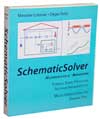Schematic Solver |
 |
|||||||||||
 |
||||||||||||
|
SchematicSolver is a Mathematica application package for drawing, solving, and implementing systems represented by schematics. It performs mixed symbolic-numeric processing. It is the first mouse-driven interactive drawing tool in Mathematica. |
||||||||||||
|
Bestellen: Lesen Sie unsere Download-Hinweise |
||||||||||||
|
Some drawing features unique to SchematicSolver:
Using SchematicSolver you can perform fast and accurate simulations of discrete-time (digital) and continuous-time (analog) systems, such as velocity servo, adaptive LMS, automatic gain control (AGC), quadrature amplitude modulation (QAM), efficient multirate, dynamic feedback and control, and nonlinear discrete-time systems, as well as square-law envelope detectors, thermodynamics of a house, high-speed recursive filters, Hilbert transformers, and digital filters. Symbolic signal processing, an innovative feature of SchematicSolver not available in other software, brings you computation of transfer functions as closed-form expressions in terms of symbolic system parameters and can find the closed-form response of the schematic. The derived result is the most general because all system parameters, inputs, and initial conditions (states) can be given by symbols. SchematicSolver features the automated generation of software implementation of linear and nonlinear discrete systems. The generated implementation function can symbolically process symbolic samples. For a symbolic input sequence you can compute the symbolic output sequence with both the system parameters and the states specified by symbols. SchematicSolver is based on the Mathematica built-in functions, graphics primitives, and palettes. Some additional special capabilities include the design of efficient multirate implementations by working in the symbolic domain, and modeling systems that work with symbolic complex signals. |
||||||||||||
|
Nur als Download erhältich. |
||||||||||||
